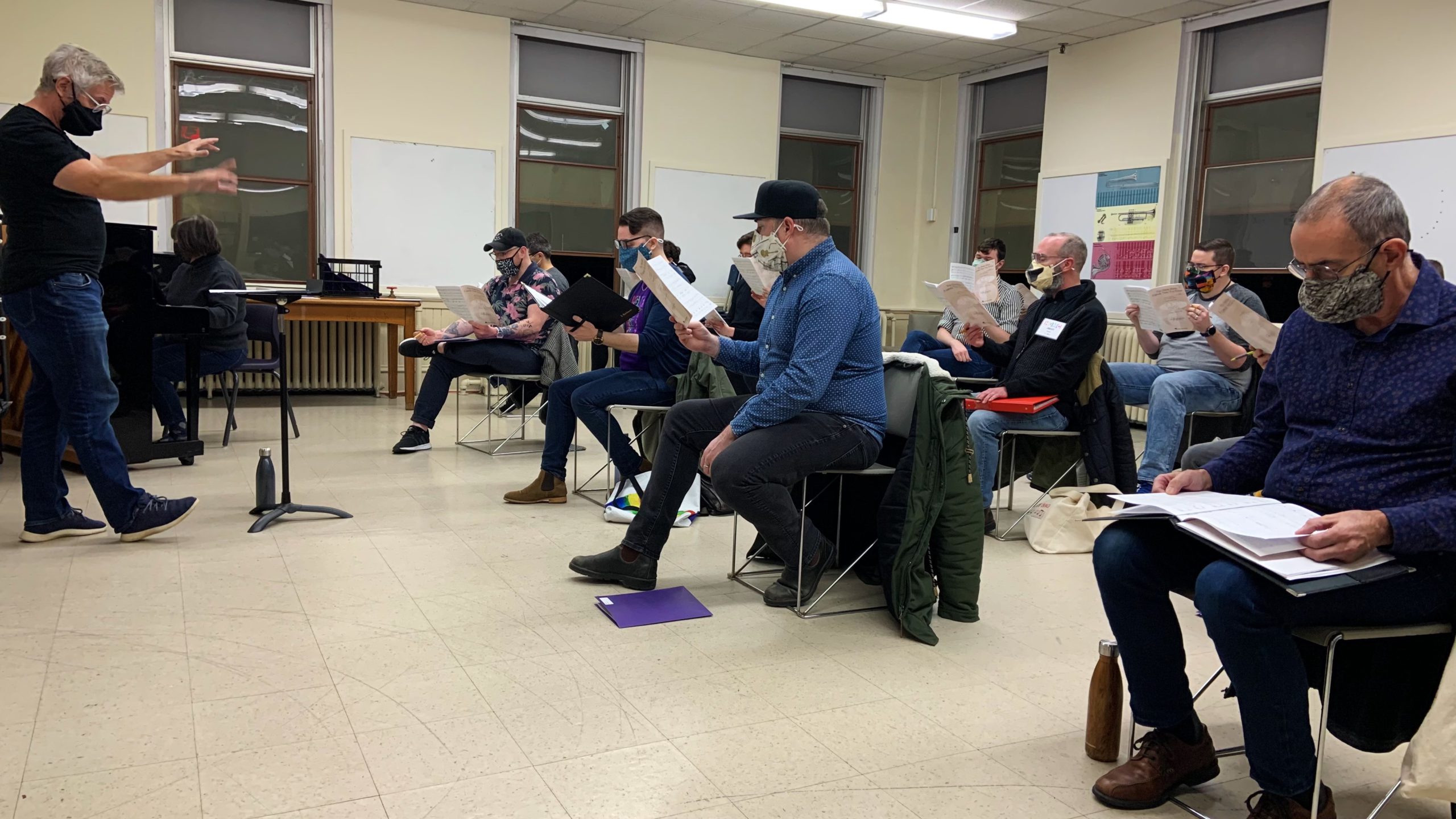How N.S. community choirs are navigating pandemic problems
Choirs are taking strict precautions in order to conduct in-person rehearsals safely

caption
The Halifax Gay Men’s Chorus rehearse for the first time this year.The atmosphere is vibrant and the attitude optimistic as the Halifax Gay Men’s Chorus learns their first song of 2021.
You have more friends than you know
Be brave, be strong
You are loved, you belong
The choristers are all wearing masks, and are distanced from each other, but they’re excited to be back at the Maritime Conservatory for Performing Arts singing together.
“This is a nice piece,” calls one member from the back of the room.
“Are you trying to get moved to the front row?” asks another.
Although in-person choir rehearsals are allowed under Nova Scotia public health guidelines, these days they look dramatically different.
A maximum of 25 members can rehearse at once, so the choir has been divided in half. The first group rehearses at 7 p.m. and a second group follows at 8 p.m.
Everyone uses hand sanitizer and signs their names in a black notebook for contact tracing. They sit in a staggered, zig-zag formation, facing the same direction, all at least six feet apart. Even when the outside temperature is freezing, the windows are opened to provide maximum ventilation.
In order to minimize aerosol transmission, the rehearsal is capped at 40 minutes. For these choristers, the opportunity to sing together is worth the brief rehearsal time and the strict precautionary measures.
“We’re used to rehearsing for 2½ hours, so we’re learning less music,” said choir member Tim Callahan-Cross. “But it’s also incredibly rewarding to just be together singing again.”
Community
In the Halifax Gay Men’s Chorus, shared experiences as part of the 2SLGBTQ+ community has created a strong feeling of kinship within the choir.
David Hutchinson, a member of the board of directors, pointed to the wide range of ages and experiences in the choir. The youngest members are in their early 20s, while the oldest are in their mid 80s.
“The fact that we’re able to cross paths with so many people that we normally wouldn’t ever talk to, let alone become friends with, that’s really been one of the most important things about the choir,” he said.
This feeling of community is common in choirs across Nova Scotia.
Heather Fraser serves as artistic director for the Aeolian Singers, a women’s choir, and the Annapolis Valley Honour Choir, a youth choir. She believes choral communities can act as a kind of support system.
Fraser says she was keenly aware of the isolation felt by many youth in the Annapolis Valley Honour Choir when in-person rehearsals ended in March. To help combat this isolation, the choir immediately began meeting online.
“I didn’t even consider stopping,” Fraser said. “I was just like ‘they need this. We just have to find a way to keep going.’”
Benefits and risks
Callahan-Cross, who is also the executive director of the Nova Scotia Choral Federation, pointed to the mental and physical health benefits associated with choral singing.
Research published by the University of Oxford shows that singing can improve breathing, posture, muscle tension, and serve as pain relief. Choral singing also releases mood-boosting endorphins and can make us feel closer with others.
These benefits are some of the reasons why choirs across Nova Scotia and Canada have been working to return to in-person rehearsals as quickly and safely as possible after initially stopping in March.
Although none happened in Canada, health officials were given pause after multiple “super-spreader” choir-related events around the world. Over two choir rehearsals in Washington last March, 53 out of 61 attendees were infected with coronavirus. Two died.
In addition to her conducting roles, Fraser is also the VP of Advocacy for Choral Canada. Since the beginning of the pandemic, she has been working with colleagues and public health officials in Nova Scotia and across Canada to develop resources for choirs and help them return to in-person rehearsals safely.
“We know now that a lot of those super-spreading events were not necessarily related to singing, but related more to the fact that there was a whole bunch of people in one room,” Fraser said.
Although loud vocalization (like singing or shouting) can increase risk of transmission of COVID-19, a report by the National Collaborating Centre for Environmental Health points to several additional risk factors including poor ventilation, lack of social distancing and lengthy rehearsals.
Although there have been few studies on the transmission of COVID-19 in choir settings, data indicates that distancing, masks, shorter rehearsals, ventilation, and proper hygiene greatly reduces transmission of COVID-19.
According to research cited by Choral Canada, 3.5 million Canadians sing in a choir and 50 per cent more adult Canadians sing in a choir than play hockey. Choral singing is more integral to Canadian life than people may realize, and it left a void when it was taken away.
“It’s the energy,” Fraser said. “That atmosphere that you get in those rehearsals that can be so electric that was so missing from their lives.”
About the author
Darrell Roberts
Darrell Roberts is a student journalist from St. John's. He enjoys reading and writing about the latest in culture and politics.
